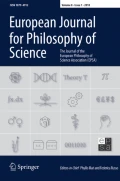Publications
“De Lobos, madres y jefes. Convenciones narrativas, discurso de género y divulgación de historia natural”
A book chapter by Dr. Carlos Tabernero, director of the iHC and professor at the UAB.
ABSTRACT
Over the past decades, issues related to animal ethics and the (audio)visual representation of non-human animals have become central to Western cultural discourses that explore the meaning of identity categories as experiential frameworks. Far from being isolated discriminatory practices, speciesism and sexism represent parallel forms of domination rooted in narratives upheld by traditions and conventions that perpetuate abuse and exploitation. In light of the growing critical interest in the documentary genre as a format for questioning and/or reinforcing normative narratives, this volume brings together a series of studies whose common denominator is the intersectionality between the constructs of gender, sexuality, and non-human animals in a selection of animal rights, nature, and wildlife documentaries. Throughout its seven chapters, the authors trace the narrative parameters, cinematic techniques, and rhetorical strategies of persuasion employed by documentaries in their exploration of new readings of the life, objectification, and death of non-human animals in an undeniably anthropocentric and androcentric world.
To cite this book chapter:Tabernero, Carlos (2025). “De Lobos, madres y jefes. Convenciones narrativas, discurso de género y divulgación de historia natural”. En Alonso Recarte, Claudia (ed.) Género y sexualidad en el documental animalista y de naturaleza. Valencia: Tirant Lo Blanch, pp. 181-200.
Published by Editorial Tirant Lo Blanch, Plural Collection; Print ISBN: 9788410811188, eBook ISBN: 9788410811195.
"Networks of queer reproduction in Sappho magazine (1972-1981)"
New paper by Dr. Rebecca Close (Postdoctoral Marie S. Curie fellowship -Dorothy program-, visitor researcher at iHC) in volum 34-1, of Journal of Gender Studies.
The paper has been published on Taylor&Francis online, in open access here.
Urban Narratives about Nature. Socio-Ecological Imaginaries between Science and Entertainment
Book by Dr. Carlos Tabernero (UAB profesor & iHC director) as a editor, at Lexington Books.

ABSTRACT
When more than half of the Earth population lives in cities, and living conditions worldwide suffer from a steady increase in environmental issues, historical inquiry provides useful reflections and new perspectives on the present. Urban Narratives about Nature: Socio-Ecological Imaginaries between Science and Entertainment aims at generating specific historical knowledge concerning processes of production, circulation, and management of natural history narratives and the associated struggles for meaning within the socio-ecological relations involved. The city is a powerful storyteller, and this book, upon a relational perspective, provides a diverse and interrelated collection of case studies of urban-based production and circulation of narratives about nature. Altogether, these cases probe the complex relationships among scientific authority, public awareness, policymaking, corporate and political interests, and environmental advocacy, in effect expanding the interdisciplinary linking of urban and environmental history within a global history view.
CONTENT
Acknowledgments
Introduction: Narrating Nature from the City
Part I: Between Academia and Activism
Chapter 1: Miquel Crusafont and Sabadell: Narratives about Paleontology (Spain, 1950‒1973)
Chapter 2: Environmentalism in Transition
Part II: Between Knowledge and Entertainment
Chapter 3: Wild at Heart: Zoological Gardens and the Urban Space
Chapter 4: Mass Media and Urban Animals in History: The View from Interwar Britain
Chapter 5: Teaching and Tinkering with Personal Computers in Catalan Rural Schools and Summer Camps (Spain, 1980s‒1990s)
Part III: Between Film and Literature
Chapter 6: The Countryside in the Frame: Film Representations of Nature under Franco’s Dictatorship
Chapter 7: Hunting Narratives in Twentieth-Century Spain: The Case of Miquel Delibes
Chapter 8: From El Modena to Terminator: Imagining Green Utopian Places for the Anthropocene
Part IV: Between Natural History and Television
Chapter 9: Percy Smith: The Triple Liminality of an Urban Natural History Filmmaker in Interwar Britain
Chapter 10: The Granada TV and Film Unit at the London Zoo: “Creating Adequate Opportunity for Observing Patterns for Amateur and Professional Zoologists Alike”
Chapter 11: Televising Nature as Modernization: El Hombre y la Tierra (Man and the Earth, 1974‒1981) in 1970s Spain
Afterword: City of Silence, City of Stories: Or of Ghosts, Doors, and Subversion
About the Contributors
ISBN: 978-1-66695-060-1 (paper) | 978-1-66695-061-8 (ebook)
'Liquid assets': Coastal wetlands, regional parks, and the protection of Mediterranean deltas
Paper by Dr. Santiago Gorostiza (Postdoctoral Researcher at iHC in the volume 3 (4), of Coastal Studies & Society.
The paper has been published online, in open access here.

ABSTRACT
After a century of accelerating drainage, in the 1960s coastal wetlands became the object of unprecedented protection campaigns around the world. This paper compares the history of three successful cases of coastal wetland protection in the Mediterranean between the 1960s and 1980s: the Rhône (France), Po (Italy), and Ebro (Spain) River deltas. As most of the coast of Mediterranean Europe, these three cases were at the centre of renewed redevelopment attempts, to further expand intensive agriculture, industry, and seaside tourism, which invariably involved wetlands drainage. In these three cases, protection was achieved by establishing “regional parks” in the deltas. We argue that it was not by chance. Wetland advocates at the international, national, and local scales coated their plea for protection in the language of economics, making the case for wetlands’ value as “liquid assets.” They argued that wetland protection could rhyme with development and, abandoning initial projects to protect deltas as national parks, focused their efforts on creating regional parks instead. Stemming from the European regional planning movement, the regional park framework proved expedient to combine development expectations and wetland protection. Thanks to modular land use zoning, it promised to combine productive activities with protected areas, without imposing uniform restrictions on the entire deltas such as those often associated with national parks. The history of these three coastal parks, therefore, sheds light on the counterintuitive but strong relationship existing between coastal development and protection by uncovering the discursive strategies and unlikely coalitions that made conservation possible.
Cite this article:
Gorostiza, S., Parrinello, G., & Aguettaz-Vilchez, D. (2024). “Liquid assets”: Coastal wetlands, regional parks, and the protection of Mediterranean deltas. Coastal Studies & Society, 3(4), 181-202. https://doi.org/10.1177/26349817241282720
"The Collective Responsibilities of Science: Toward a Normative Framework"
Article del Dr. Vincenzo Politi (Becari postdoctoral Beatriu de Pinós de l'iHC) al volum 91, de Philosophy of Science.
L'article ha estat publicat a Cambridge University Press en accés obert, que es pot llegir aquí.
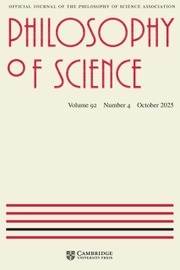
"Kuhnian Lessons for the Social Epistemology of Science"
New paper by Dr. Vincenzo Politi (Postdoctoral Fellow Beatriu de Pinós at iHC) in the volume 345, of Boston Studies in the Philosophy and History of Science, p. 31-49.
Paper has been published on Springer Link.

Abstract
Kuhn’s analysis of the structure and function of the scientific community has been recently re-interpreted as a seminal contribution to the so-called social epistemology of science. Kuhn’s social epistemology should be considered as part of a normative-descriptive philosophical framework in which epistemological, historical, sociological, and psychological elements are interconnected. In this chapter, I will compare Kuhn’s seminal insights with two contemporary approaches to the social epistemology of science, namely: the development of idealised formal models of the scientific community and the use of qualitative studies for philosophical purposes. On the one hand, these contemporary approaches to social epistemology may be regarded as developing some of Kuhn’s views in new and exciting ways. On the other hand, however, it is still not entirely clear which kind of general philosophical ‘image of science’ they are contributing to. This chapter, therefore, aims at illuminating how analysing some of the contemporary debates in social epistemology through the lenses of Kuhn’s philosophy may recast under a new light the issue of the value of the study of the social dimension of scientific research for general philosophy of science.
Para citar este artículo:
Politi, V. (2024). Kuhnian Lessons for the Social Epistemology of Science. In: Shan, Y. (eds) Rethinking Thomas Kuhn’s Legacy. Boston Studies in the Philosophy and History of Science, vol 345. Springer, Cham. https://doi.org/10.1007/978-3-031-64229-6_3
DOI: https://doi.org/10.1007/978-3-031-64229-6_3
Resistance: A Journal of Radical Environmental Humanities
- Volume 11, Number 1, Winter 2023, From Resilience to Resistance: An Almost New Journal for Environmental Humanities.
Editor-in-chief: Dr. Marco Armiero

Resistance: A Journal of Radical Environmental Humanities, From Resilience to Resistance: An Almost New Journal for Environmental Humanities, Volume 11, Number 1, Winter 2023, we can find several articles of iHC members in a collective editorial:
-From Resilience to Resistance: An Almost New Journal for Environmental Humanities
Marco Armiero, pp. 1-4, DOI: https://doi.org/10.1353/res.2023.a931662
-The Dark Side of the White Alps: Guerrilla Narratives in the Marble Landscape of Tuscany
Chiara Braucher, Marco Armiero, pp. 105-123, DOI: https://doi.org/10.1353/res.2023.a931668
-Living a Lie: Leave the World Behind by Sam Esmail (review)
Carlos Tabernero, pp. 158-163, DOI: https://doi.org/10.1353/res.2023.a931670
Resilience: A Journal of Environmental Humanities is entering a new phase in its evolution. Under the leadership of the new editor-in-chief, Marco Armiero, the journal is undergoing a significant transformation and will now be known as Resistance: A Journal of Radical Environmental Humanities. This change in title is designed to provide clarity about the journal’s intellectual direction in its new series. While ‘resilience’ pertains to the ability to endure stressors and return to a prior state, ‘resistance’ is about taking action to challenge and change the conditions that lead to crises. As activists emphasized during the COVID-19 pandemic, the goal should not be a return to ‘normality,’ as ‘normality’ itself was part of the problem (Nebraska Press Journals, University of Nebraska).
ISSN: 2996-4849
"The Fertility Fix: the Boom in Facial-matching Algorithms for Donor Selection in Assisted Reproduction in Spain"
New paper by Dr. Rebecca Close (MSCA Dorothy Postdoctoral Fellow and visitor fellowship at iHC) in the volume 30, of The New Bioethics.
The paper has been published on Taylor & Francis online, in open access here.
ABSTRACT
This article reads the uptake of facial-matching algorithms by fertility clinics in Spain through the lens of ‘the fertility fix’: a software fix to the social reconfiguration of kinship and a fixed capital investment made by competing fertility companies and firms. ‘The fertility fix’ is proposed as a critical, ethical lens through which to situate algorithmic facial-matching in assisted reproduction in the context of the racial politics of the face and phenotype and the spatial politics of market expansion. While an ‘infertility crisis’ is often mentioned when explaining the growth of the assisted reproductive technologies (ARTs) industry, the use of donated reproductive cells is tied up in societal, ecological and economic shifts. Combining Software Studies analysis with Marxist Feminist and trans*feminist perspectives on shifting re/production dynamics, the article details the role of computational technologies in promoting certain ideas and beliefs about family and fixing certain territories of capital flow.
Cite this article:
Close, R. (2024). The Fertility Fix: the Boom in Facial-matching Algorithms for Donor Selection in Assisted Reproduction in Spain. The New Bioethics, 1–17. https://doi.org/10.1080/20502877.2024.2371738
"The value-free ideal, the autonomy thesis, and cognitive diversity"
New paper by Dr. Vincenzo Politi (Postdoctoral Fellow Beatriu de Pinós at iHC) in the volume 204, of Synthese.
The paper has been published on Springer Link, in open access here.
ABSTRACT
Some debates about the role of non-epistemic values in science discuss the so-called Value-Free Ideal together with the autonomy thesis, to the point that they may be assumed to be intertwined. As I will argue in this article, the two are independent from one another, are supported by different arguments, and ought to be disentangled. I will also show that the arguments against value-freedom and supporting a value-laden conception of science, are different from the arguments against autonomy, which support democratized science. Moreover, while some of the arguments against autonomy and for democratized science may actually be consistent with value-freedom, they conflict with some philosophical views about the internal diversity of well-designed epistemic communities. This article distinguishes the Value-Free Ideal and the autonomy thesis, as well as their antitheses, and investigates their relations to some of the socio-epistemological models of the social organization of scientific research. Its aim is to make explicit some incompatibilities between different normative frameworks developed in philosophy of science.
Cite this article:
Politi, V. “The value-free ideal, the autonomy thesis, and cognitive diversity”. Synthese 204, 24 (2024). https://doi.org/10.1007/s11229-024-04673-1
DOI: https://doi.org/10.1007/s11229-024-04673-1
Paper by Marià Baig, iHC member & Physics PhD (UAB).
Paper at RACO: https://raco.cat/index.php/AnnalsEmpordanesos/article/view/423730/518267
Published by: Institut d'Estudis Empordanesos
DOI: https://doi.org/10.34810/20.8010.01.328
Per citar aquest article: Annals de l’Institut d’Estudis Empordanesos (AIEE), Figueres, vol. 54 (2023), pàg. 215-242
"Who ought to look towards the horizon? A qualitative study on the collective social responsibility of scientific research"
New paper by Dr. Vincenzo Politi (Postdoctoral Fellow Beatriu de Pinós at iHC) in the volume 14, of the European Journal for Philosophy of Science.
The paper has been published on Springer Link, in open access here.
ABSTRACT
There is a growing concern for the proper role of science within democratic societies, which has led to the development of new science policies for the implementation of social responsibility in research. Although the very expression ‘social responsibility of science’ may be interpreted in different ways, many of these emerging policy frameworks define it, at least in part, as a form of anticipative reflection about the potential impacts of research in society. What remains a rather under-discussed issue is the definition of the bearer of the social responsibility of science. In other words, it is not clear who is supposed to engage in such an anticipative reflection, whether individual researchers or research groups. In the past few years, philosophers of science have begun to use qualitative research methods to fill the gaps between normative models of the organisation of ideal scientific communities and the reality of actual scientific practices. In this article, I follow this approach to discuss the issue of the collective dimension of the social responsibility of science. I rely on a qualitative study conducted on an interdisciplinary research group and I describe how group dynamics position individuals and distribute duties and roles, including social responsibility. Qualitative descriptions of the distribution of duties within actual research groups should inform the formulation of general prescriptive theories on the collective responsibility of science.
Cite this article:
Politi, V. Who ought to look towards the horizon? A qualitative study on the collective social responsibility of scientific research. Euro Jnl Phil Sci 14, 19 (2024). https://doi.org/10.1007/s13194-024-00580-x
The Land of the Hunger Artists. Science, Spectacle and Authority, c. 1880-1922.
Book by Agustí Nieto-Galán, iHC director & UAB professor.
Published by Cambridge University Press
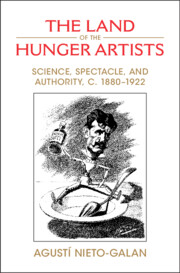
Book description
From the 1880s to the 1920s, hunger artists - professional fasters - lived on the fringes of public spectacle and academic experiment. Agustí Nieto-Galan presents the history of this phenomenon as popular urban spectacle and subject of scientific study, showing how hunger artists acted as mediators between the human and the social body. Doctors, journalists, impresarios , artists, and others used them to reinforce their different philosophical views, scientific schools, political ideologies, cultural values, and professional interests. The hunger artists generated heated debates on objectivity and medical pluralism, and fierce struggles over authority, recognition, and prestige. Set on the fringes of the freak show culture of the nineteenth century and the scientific study of physiology laboratories, Nieto-Galan explores the story of the public exhibition of hunger, emaciated bodies, and their enormous impact on the public sphere of their time.
Els càtars: 50 indrets del catarisme occitanocatalà
Author: Sergi Grau, member of iHC and professor at UAB.
Published by Cossetània Editorial.

ABSTRACT
The book Els càtars: 50 indrets del catarisme occitanocatalà, published by Sergi Grau, is a unique guide that recounts stories lived by Cathars in various places in Catalunya and Occitania.
Es tracta d'una aproximació diferent als indrets càtars. El turisme ha potenciat el Camí dels Bons Homes, un itinerari turístic transpirinenc que ha donat a conèixer els llocs més emblemàtics dels càtars a les comarques de l’Alt Urgell, el Berguedà, el Solsonès i la Cerdanya, juntament amb els famosos —i mal anomenats— castells «càtars» occitans. Però, al territori, hi ha moltes altres ciutats i viles que també tenen la seva història amb els càtars, ciutats que s’estenen de nord a sud i que arriben fins a València, Aragó o Mallorca. I aquestes són les històries que s’hi expliquen. El seu testimoni ens apropa d’una manera o altra al pas d’aquests homes i dones que van creure en el catarisme per una vila, un carrer, una plaça o una església d’aquests 50 indrets del territori occitanocatalà.
ISBN: 978-84-1356-306-0 (paper, tapa dura)
Beyond Structure: New Frontiers of the Philosophy of Thomas Kuhn
Editorial paper by Dr. Vincenzo Politi (Postdoctoral Fellow Beatriu de Pinós at iHC) y Yafeng Shan in the special volume of the journal "International Studies in the Philosophy of Science" that they have co-edited.
The paper has been published on Taylor & Francis online and can be accessed here: https://www.tandfonline.com/doi/full/10.1080/02698595.2023.2264158
ABSTRACT
Thomas Kuhn (1922-1996) is widely considered as one of the most important philosophers of science of the 20th century, while his The Structure of Scientific Revolutions (SSR) is regarded as one of the most influential works in the philosophy ofscience. At the same time, however, his place within philosophy of science remains ambiguous. On the one hand, despite the popularity of SSR, there is no proper ‘Kuhnian school of thought’ in HPS. On the other hand, the interest towards Kuhn does not seem to fade away and the number of publications about his work does not seem to decrease. We suggest that there are at least three different ways to go ‘beyond SSR’: (i) by scrutinising the development of Kuhn’s thought, from his pre- to his post-SSR writings; (ii) by contextualising Kuhn in the philosophical milieu of his time, thus interpreting his view as emerging from the intellectual exchanges he had with contemporary philosophers; (iii) by reinterpreting and developing some of his most known ideas, in ways that perhaps Kuhn himself was not able to contemplate.
Ciudad Pánico. Morfologías urbanas del horror
Coordinat per Ángel Sala y Jordi Sánchez-Navarro, el llibre comta amb la participació de Carlos Tabernero, membre de l'iHC i professor de la UAB. Il·lustracions: Miki Edge
Llibre oficial de SITGES / Festival Internacional de Cinema Fantàstic de Catalunya
ISBN: 978-84-126027-5-3
Publicat per Editorial Hermenaute

Abstract
¿Qué tienen en común la onírica Venecia, la ciudad de la muerte, con Los Ángeles, la ciudad de los sueños? ¿La «culta» Nueva York con la «industriosa» Detroit? ¿Un suburbio de Estados Unidos con el centro de Roma? Todos ellos son escenarios del miedo contemporáneo. Cartografías del terror que toman forma de ciudad. Laberintos para las ansiedades de nuestro tiempo. Coordinado por Ángel Sala y Jordi Sánchez-Navarro. Libro oficial de SITGES ? Festival Internacional de Cinema Fantàstic de Catalunya.
Las ciudades se reflejan en el género como centros densos de actividad humana, albergan tanto sueños como pesadillas y brindan un terreno fértil para que los cineastas exploren emociones que solo tienen sentido en el marco de la vida urbana. En esos enfoques, el aislamiento y la alienación se convierten en temas centrales.
Table of contents
-Jordi Sánchez-Navarro habla en el primer capítulo de la representación de algunas ciudades italianas legendarias en el cine de terror y su relación con el concepto de lo sublime terrorífico.
-Jorge Gorostiza analiza, a través de los nombres y la morfología urbana, como funcionan las urbes imaginadas y los pueblos inventados en las ficciones cinematográficas.
-Los guetos y los suburbios residenciales son el material que ha tratado Victoria Santamaría Ibor en su capítulo.
-Símbolo del colapso del siglo XX, Detroit es el escenario predilecto del terror contemporáneo que analiza Lluís Rueda.
-Ángel Sala nos propone recorrer los mil y un horrores de la ciudad total, las grandes megalópolis urbanas de la modernidad.
-Antonio José Navarro nos acompaña en una muy especial cartografía española del miedo urbano.
-Carlos Tabernero pone el foco en la representación de las ciudades abandonadas.
-El volumen se cierra con una selección de películas brevemente comentadas por Xavi Sánchez Pons y Ángel Sala.
-Con motivo del festival de Sitges, ponemos a disposición de forma gratuita una versión extendida del artículo de Ángel Sala en este enlace: https://www.hermenaute.com/docs/ciudad_total.pdf.
Special Issue: Science at the Zoo: Producing Knowledge about Exotic Animals, edited by Miquel Carandell & Oliver Hochadel. Centaurus. Journal of the European Society for the History of Science, Volume 64 (2022), Issue 3.
Abstract
Was the zoo a place for science in the nineteenth and twentieth centuries? This Special Issue addresses this question with case studies that focus on individual animals such as anteaters, axolotls, dolphins, hoatzins, kangaroos, cassowaries and tarpans. The eight articles ask in how far the specific conditions of the zoo enabled but also conditioned or even impeded the generation of knowledge. And they show how closely intertwined these investigations were with issues of taxonomy, breeding, conservation and practical zoo management.
Table of contents
Oliver Hochadel: Science at the Zoo. An Introduction
Helen Cowie: A Tale of Two Anteaters: Madrid 1776 and London 1853
Christian Reiß: Knowing is surviving. The Mexican Axolotl, two Paris Zoos and the Role of Practical Knowledge in Keeping Unknown Animals, 1850-1876
Oliver Hochadel: How to get into the Pouch. Solving the riddle of the kangaroo birth (1826-1926)
Elle Larsson: "Here they are in flesh and feather": Walter Rothschild’s "private zoo" and the preparation and taxonomic study of cassowaries
Valentines-Álvarez, Jaume; Sastre-Juan, Jaume (2022), “A Fascist Coney Island? Salazar’s Dictatorship, Popular Culture and Technological Fun (1933-1940)”, in Simões, Ana; Diogo, Maria Paula (eds.), Lisbon (1880-1940): Visions and Identities of a Techno-Scientific Atlantic Capital, Leiden: Brill, 391-418.
Abstract
This chapter deals with the place of amusement parks in Lisbon’s geographies of leisure during the first decade of the Estado Novo (1933–1943). At a time in which the regime was developing its own model of fascist modernity, what form did the international, urban and mechanical fun of amusement parks take under Salazarism? By analyzing the different regimes of pleasure of the three major spaces of technological fun of the period (the Luna Parque at the Eduardo VII Park, 1933–35; the amusement park of the 1940 Exhibition of the Portuguese World in Belém; the Feira Popular created in 1943 in Palhavã) we explore the relations between global mass culture and the cultural program of the Estado Novo.
Miquel Carandell Baruzzi (2022). ‘Ugly and smelly or useful insect hunters?’ Perceptions of and attitudes towards bats in the turn of the twentieth-century public sphere in Barcelona. Public Understanding of Science, Volume 32, Issue 1
Abstract
In recent years, historians and sociologists of science have shown how turn of the century natural history research and its public communication in Barcelona was intrinsically attached to certain political orientations and the historical context. Likewise, the way society perceived bats and promoted their ecological services has been increasingly researched by the community of bat researchers. In this article, I describe attitudes towards and perceptions of bats in the ‘public sphere’ of Barcelona in that period and examine them using public communication of science and history of science analytical tools. I performed an exhaustive search of the available newspaper and magazine articles using the Catalan and Spanish words for ‘bat’ in the online search engines of the national Catalan and Spanish libraries from 1888 to 1929. I compiled and reviewed a wide range of periodicals, covering different political orientations and representing several different types of publication. The articles were classified into four different categories. First, bats were commonly used as a symbol to represent the city and right-wing, conservative politics. Second, bats were often linked to negative adjectives that portrayed them as ugly, disgusting or diabolic. Third, many articles made an active effort to stop children chasing and killing bats. And fourth, I also identified a non-organised group of popularisers across the whole media spectrum who promoted what we call today the ecological services provided by bats, and especially their role as agricultural pest controllers. This study provides a better understanding of science popularisation, and specifically, perceptions of and attitudes towards bats during the studied period. This approach illustrates how historical accounts can be used today to improve perceptions of bats and suggest a more complex context of science popularisation.
Carlos Tabernero, "The Case of the Killer She-Wolf: Media, the Natural Sciences, and the Construction of the Environment in Late Franco’s Spain". Volume 52, Issue 4 of Historical Studies in the Natural Sciences (September 2022)
Abstract:
In July 1974, a she-wolf allegedly killed two children in Ourense (Spain). A press outburst followed, with a heated debate about the extermination or conservation of wolf populations. This article examines that media coverage as a highly illustrative example of a multilayered process of natural history knowledge construction. The initial focus on the legal standing of wolves soon turned to an argument about Spain’s modernization, a central contention during Franco’s dictatorship, particularly in the last two decades. In a context of the rise of the natural sciences as a noteworthy field of sociopolitical negotiation worldwide, the scientific definition and management of natural heritage, intertwined with nationalist and internationalist rationales that were integral to the regime’s enduring legitimation strategies, quickly became central issues. In addition, Felix Rodríguez de la Fuente (1928–1980), a highly influential naturalist, media icon, and celebrity champion of wolves, whose stance of a scientifically based activism elicited mixed feelings in late Franco’s Spain, was quickly drawn into the quarrel with shepherds, hunters, scholars, policymakers, and journalists. His involvement, against a backdrop of locally situated and environmentally related conflicts, allows us to analyze the ambivalent role of science, media, and celebrity in the establishment of the epistemological status of local/rural and outsider/urban knowledge in the construction of narratives about nature. In all, this case brings together official mechanisms of production of scientific knowledge, various forms of public and institutional engagement, a wide range of people’s everyday-life experiences, and the crucial involvement of the media.
Keywords:
media, environment, Franco’s regime, human–wildlife conflicts, natural history knowledge production, rural/urban boundaries, celebrity
History of Science, Volume 60, ISSUE 3 (August 2022)
Special section: Science popularization under Franco
- Introduction: Science popularization, dictatorships, and democracies Clara Florensa and Agustí Nieto-Galan
- Struggling for survival: The popularization of Darwinism and the elite’s fight for power in Franco’s Spain (1939–1967) Clara Florensa
- A puzzling marriage? UNESCO and the Madrid Festival of Science (1955) Agustí Nieto-Galan
- Animals for the mayor: Barcelona’s zoo in the making of local policies and national narratives (1957–73) Miquel Carandell Baruzzi
Abstract
The study of science popularization in dictatorships, such as Franco’s regime, offers a useful window through which to review definitions of controversial categories such as “popular science” and the “public sphere.” It also adds a new analytical perspective to the historiography of dictatorships and their totalitarian nature. Moreover, studying science popularization in these regimes provides new tools for a critical analysis of key contemporary concepts such as nationalism, internationalism, democracy, and technocracy.
Adrián Almazán & Jaume Sastre-Juan; Tal vez no habrá paisaje después de la batalla, www.elsaltodiario.com [12/05/2022]
Abstract
Las tecnologías son moral materializada, son política por otros medios, pautan formas de vida, posibilitan e inhiben mundos. La nuclear también. Muchos críticos de la energía nuclear han apuntado no sólo a sus peligros ecológicos, sino a su nocividad social.
Agustí Nieto-Galan; La “religió” de la ciència a l’Escola Moderna. I Simposi Internacional Ferrer Guàrdia, pp.37-57.
Abstract
Presentem el document de recull de totes les comunicacions acceptades en el Simposi. En primer lloc, el text en llengua francesa de la conferència inaugural impartida pel professor Wagnon sobre el tema “La dimension européenne de Francisco Ferrer”. A continuació, les tretze comunicacions presentades i avaluades pel comitè científic que s’han estructurat en dues parts: “Els principis educatius de l’Escola Moderna” i “La presència i la influència de Ferrer i Guàrdia i l’Escola Moderna”.
Articles Simposi FG [DOWNLOAD]
Xavier Roqué; "Small agency in the nuclear anthropocene. Local Words for the Palomares Accident" in Anthropogenic Markers: Stratigraphy and Context, eds. Christoph Rosol and Giulia Rispoli (2022)
ISSN: 978-84-18982-77-4
Anthropogenic Markers: Stratigraphy and Context
The special publication Anthropogenic Markers: Stratigraphy and Context explores and contours some of the historical contexts, epistemic settings, and conceptual interventions around the ongoing work of Anthropocene geology. In seven thematic dossiers, contributions from the fields of geochemistry and paleobiology, history and science studies, artistic research, archaeology, literary studies, and anthropology reflect on selected material markers of human impacts on earthly strata. Taken together, they form a unique interdisciplinary conversation across positions and perspectives, helping to map out and expand upon the many ways of tracing the evidence that defines the onset of a human-dominated and crisis-laden epoch.
Verónica Ramírez, Elisa Sevilla, Agustín Nieto-Galan (eds), Astronomía, Literatura y espiritismo. Camille Flammarion en América Latina. RIL editores, 2022.
ISSN: 978-84-18982-77-4
Abstract
La figura del astrónomo y divulgador francés Camille Flammarion (1842-1925) tuvo un gran impacto en la cultura latinoamericana de fines del siglo XIX y principios del XX. Su obra, de carácter heterogéneo, conformada por ensayos científicos, artículos de divulgación, novelas e incluso textos espiritistas, fue apropiada por intelectuales, políticos, artistas y científicos, e impregnó debates, tertulias, impresos y efemérides, tanto entre las élites como en las clases populares. Más que una recopilación de casos nacionales, este volumen colectivo presenta algunos de los «itinerarios», hasta ahora desconocidos, que siguió el saber astronómico de Flammarion en América Latina.
"Wildlife comics, or the making of young naturalists in late Franco’s Spain (1969–1970)", Journal of Science Communication, Volume 21, February 2022. DOI: https://doi.org/10.22323/2.21010205
Download:
Abstract:
This essay examines a highly popular comic series published in Spain between 1969 and 1970 which focused on Felix Rodríguez de la Fuente (1928–1980), a prominent and influential naturalist and media icon, as main character. These comics constitute a remarkably illustrative example of the use of popular media in processes of construction of natural history knowledge. Situated in the complex final years of Franco's regime, they allow us to probe the combined role of science, media, and celebrity in the construction of a visual environmental culture through storytelling strategies designed to engage young audiences in naturalist-like practices.
Agustí Nieto-Galan, "Useful charlatans: Giovanni Succi and Stefano Merlatti’s fasting contest in Paris, 1886". Science in Context, Volume 33/ Number 4. Published online by Cambridge University Press: 28 January 2022
ISSN: 0269-8897 (Print), 1474-0664 (Online)
https://www.cambridge.org/core/journals/science-in-context/issue/7724E401D3ADC52669E147A23A031957
Argument:
This paper analyzes the public fasts of two Italian “hunger artists,” Giovanni Succi and Stefano Merlatti, in Paris in 1886, and their ability to forego eating for a long period (thirty and fifty days respectively). Some contemporary witnesses described them as clever frauds, but others considered them to be interesting physiological anomalies. Controversies about their fasts entered academic circles, but they also spread throughout the urban public at different levels. First, Succi and Merlatti steered medical debates among physicians on the “scientific” explanations of the limits of human resistance to inanition, and acted as ideal mediators for doctors’ professional interests. Second, they became useful tools for science popularizers in their attempt to gain authority in drawing the boundaries between “orthodox” and “heterodox” knowledge. Finally, in the 1880s, Succi and Merlatti’s contest, the controversy around the liquids they ingested, and their scientific supervision by medical doctors, all reinforced their own professional status as itinerant fasters in a golden decade for that kind of endeavor. For all those reasons, Succi and Merlatti can be viewed as useful, epistemologically-active charlatans.
Agustí Nieto-Galan and Peter J. Ramberg, “Culture and Science: Chemistry Spreads Its Influence”, in A Cultural History of Chemistry in the Nineteenth Century, edited by Peter J. Ramberg, Bloomsbury. London, 2021, pp. 117-138.
https://www.bloomsbury.com/uk/cultural-history-of-chemistry-9781474294928/
Description
From prehistoric metal extraction to medieval alchemy to modern industry, chemistry has been central to our understanding and use of the physical world as well as to trade, warfare and medicine. In its turn, chemistry has been shaped by changing technologies, institutions and cultural beliefs. A Cultural History of Chemistry presents the first detailed and authoritative survey from antiquity to today, focusing on the West but integrating key developments in Egypt, Mesopotamia, and the Arabic-Islamic and Byzantine empires.
Chapter titles are identical across each of the volumes. This gives the choice of reading about a specific period in one of the volumes, or following a theme across history by reading the relevant chapter in each of the six. The themes (and chapter titles) are: Theory and Concepts; Practice and Experiment; Sites and Technology; Culture and Knowledge; Society and Environment; Trade and Industry; Learning and Institutions; Art and Representation.
The six volumes cover: 1 – Antiquity (3,000 BCE to 600 CE); 2 – Medieval Age (600 to 1500); 3 – Early Modern (1500 to 1700); 4 – Eighteenth Century (1700 to 1815); 5 – Nineteenth Century (1815 to 1914); 6 – Modern Age (1914 to the Present).
The page extent for the pack is 1728pp. Each volume opens with an Introduction and concludes with Notes, Bibliography, and an Index.
Lévy, S., Huertas-Maestro, M., & Huertas, R. (2021). The reception of psychodrama in Spain: Correspondence between Jacob Levy Moreno and Ramón Sarró. History of Psychology. Advance online publication. https://doi.org/10.1037/hop0000206
Jacob Levy Moreno, the well-known creator of psychodrama, had a close epistolary relationship with the Spanish psychiatrist Ramón Sarró; a collection of these letters has been located in the Sarró personal archive, deposited in the Library of Catalonia. After locating and arranging this correspondence, we proceeded to analyze and contextualize its contents. The analysis of this collection serves as a basis to outline the context in which the relationship between Moreno and Sarró developed, the role played by certain psychotherapy congresses in strengthening their relationships, and the process that resulted in the University of Barcelona awarding Moreno Doctor Honoris Causa. This study has allowed us to identify certain areas of how psychodrama was received in Spain during the 1960s and reflect on the creation of international collaboration networks and the creation of schools and professional and academic legitimation strategies in the wake of the approaches to group psychotherapy and psychodrama that Moreno developed while based in New York. (PsycInfo Database Record (c) 2021 APA, all rights reserved).
“‘Science in Action’: The Politics of Hands-on Display at the New York Museum of Science and Industry”, History of Science, Volume 59 Issue 2, June 2021 [Published online on June 8th 2018]; to be included within the forthcoming special issue ‘The Spatial Inscription of Science: Politics and Practices since 1900’, edited by Andrée Bergeron and Charlotte Bigg].
This article analyses the changing politics of hands-on display at the New York Museum of Science and Industry by following its urban deambulation throughout Manhattan, which went hand in hand with sharp shifts in promoters, narrative and exhibition techniques. The museum was inaugurated in 1927 as the Museum of the Peaceful Arts in the 7th and 8th floors of the Scientific American Building. It changed its name in 1930 into the New York Museum of Science and Industry while in the 3rd and 4th floors of the Daily News Building. And it was close to being renamed as Science Center when it finally moved in 1936 to the ground floor of the Rockefeller Center. The analysis of how the political agenda of the different promoters of the New York Museum of Science and Industry was spatially and performatively inscribed in each of its sites suggests that the boom of visitor-operated exhibits had nothing to do with an Exploratorium-like rhetorics of democratic empowerment. The social paternalistic ideology of the vocational education movement, the ideas on innovation of the early sociology of invention, and the corporate behavioural approach to mass communications are more suitable contexts in which to understand the changing politics of hands-on display in interwar American museums of science and industry.
https://journals.sagepub.com/toc/hosa/59/2
"Cultural Histories of Science in Franco’s Spain", Culture & History Digital Journal, Vol. 10 No. 1 (2021) [https://doi.org/10.3989/chdj.2021.v10.i1]
Editorial
Introduction to the Special Issue “Cultural Histories of Science in Franco’s Spain”, Enric J. Novella, Ricardo Campos
Dossier
Constructing “Pure” and “Applied” Science in Early Francoism, Agustí Nieto-Galan
The cultural significance of physics and evolution in Francoist Spain: continuity and development in the autarchic period, Clara Florensa, Xavier Roqué
From arsenic to DDT: Pesticides, Fascism and the invisibility of toxic risks in the early years of Francoist Spain (1939-1953), Silvia Pérez-Criado, José Ramón Bertomeu Sánchez
Atomic Routes and Cultures for a New Narrative on Franco’s Regime, Ana Romero de Pablos
Racism, Hispanidad and social hierarchy in medicalpsychiatric thought during early Francoism. The work by Misael Bañuelos (1936-1941), Ricardo Campos
“The Faustian spirit of the technical world”. Mental illness and cultural criticism in Franco’s Spain, Enric J. Novella
Between modernity and tradition: the formation of a psychoanalytical culture during the Franco dictatorship, Silvia Lévy Lazcano
"La venganza de la naturaleza. 50 narrativas en torno al medio ambiente". Col·lecció: Filmografías esenciales
We live in a world of environmental crossroads: pollution of land, air and water, overexploitation of resources, rampant greenhouse gas emissions, systematic destruction of ecosystems and biodiversity, and demographic and socioeconomic imbalances in the delusion of rampant consumption and our colonial, class, gender and race reclusions, which inevitably confront us with our ways of living and dying.With cinema, which offers us endless ways to look at ourselves in our communities, we can explore with peculiar narrative freedom our ways of understanding nature, our expectations, our misgivings, the profound contradictions in the way we organize ourselves and to build, historically, the environment in which we dream, suffer and love.Cinema shows us that the revenge of nature is nothing more than a terrifying pretext, and that the solutions of the destruction of the environment do not inhabit the realm of any kind of providence, but of our will.

A puzzling A puzzling marriage? UNESCO and the Madrid Festival of Science (1955), Clara Florensa and Agustí Nieto-Galan (eds), "Popular Science under Franco", History of Science (Febrary 2021).
From 17 to 22 October 1955, Madrid hosted the UNESCO Festival of Science. In the early years of the Cold War, in a dictatorial country that had recently been admitted into the international community, the festival aimed to spread science to the public through displays of scientific instruments, public lectures, book exhibitions, science writers professional associations, and debates about the use of different media. In this context, foreign visitors, many of whom came from liberal democracies, seemed comfortable in the capital of a country ruled by a dictatorship that had survived after the defeat of fascism in the Second World War and was struggling to gain foreign recognition after years of isolation.
This article analyzes the political role of science popularization in Madrid at that time. It approaches the apparently puzzling marriage between UNESCO’s international agenda for peace and democracy and the interests of the Francoist elites. Shared views of technocratic modernity, the fight against communism, and a diplomacy that served Spanish nationalism, paved the way for the alliance.
El Taxidermista de la plaça Reial és una crònica, escrita per Miquel Carandell, que recull la història del comerç singular que va obrir a finals del segle XIX a la Plaça Real, un relat explicat des d’una triple perspectiva, la històrica, l’emotiva de la mà de Núria Viladevall Palaus, besneta de Soler Pujol, i la construïda amb diferents testimonis.
A la vegada, la de la botiga és una història de ciència a la ciutat, una història que ens mostra la importància dels espais com les botigues pel desenvolupament científic, especialment, per generar espais de trobada i debat entre especialistes, professionals i no professionals. Alguns d’aquest últims van ser aficionats, col·leccionistes i artistes tant coneguts com Josep Maria de Segarra, Lluís Doménech i Torres (net de Doménech i Muntanter), Josep Pons Oliveras, Salvador Dalí, Gabriel Garcia Márquez, Pere Pruna, Jorge Wagensberg o els mateixos Joan Miró i Lluís Llach que s'aturaven davant els seus aparadors.
La idea de recopilar en un llibre la llarga història del “Museo Pedagógico de Ciencias Naturales” va sorgir de, Núria Viladevall Palaus, besneta de Lluís Soler Pujol, fundador de la botiga museu. El text rememora les meves vivències a partir de les olors que es generaven amb l’activitat de l’establiment. Aquest relat es complementa amb el text de Miquel Carandell, doctor en Història de la Ciència, que explica com Soler Pujol i els seus descendents van fer d’aquesta botiga singular un referent en el món de la taxidèrmia i, alhora, un espai de difusió de la història natural, de la ciència, un punt de trobada de col•leccionistes, científics, aficionats i curiosos. A més, el llibre que volem editar compta amb el testimoni de diverses persones que van conèixer l’establiment com l’escriptor i periodista Lluís Permanyer; el poeta i escriptor Vicenç Altaió; la directora de la Fundació SETBA, Cristina Sampere, Artur Ramon ; galerista d'art, entre d’altres.
https://www.verkami.com/projects/30317-el-taxidermista-de-la-placa-reial
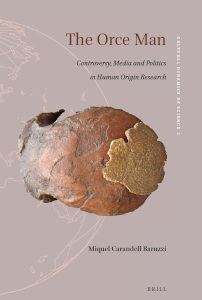
Miquel Carandell Baruzzi, associate professor at the Institut d’Història de la Ciència, is the author of the book The Orce Man: Controversy, Media and Politics in Human Origins Research, which was just published by the prestigious academic research publisher Brill. The book, the outcome of his doctoral thesis read at the Institute in 2015 and directed by Oliver Hochadel, presents the history of the controversy surrounding Orce Man.
Discovered in 1982 in the Venta Micena site in Orce, Granada, Orce Man is a small fragment of a cranium which was unveiled to the public in 1983 as a vitally important ancestor of human beings. The fragment was regarded by its discoverers, Josep Gibert, Jordi Agustí and Salvador Moyà-Solà, researchers at the Institut Paleontològic de Sabadell, as the oldest hominid in Europe, the “first European”. The discovery garnered unexpected media, political and even scientific attention. One year later, the French partners of the Catalan researchers began to question the validity of the find. These doubts were funnelled to the press, where an intense controversy erupted which has lasted almost 30 years.
In this book, Carandell uses the tools, methodology and historiography of the history and sociology of science to present a chronological story of the Orce controversy, at times tracking the story as it developed day by day. This detailed attention attempts not to reveal whether or not the fragment called “Orce Man” was in fact human remains but to show under what circumstances, often social, political or even personal, certain scientific statements are credible and accepted by both experts and the public at large, while others are not. By situating the controversy within its historical, political, social and scientific context, this book shows how the line separating scientific success from failure is often narrower than what it may seem and is closely tied to its political attention and public perception.
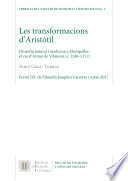
Les transformacions d’Aristòtil. Filosofia natural i medicina a Montpeller: el cas d’Arnau de Vilanova (c. 1240-1311). Philosophy award Joaquim Carreras i Artau 2017 from the Institut d’Estudis Catalans (Barcelona: Institut d’Estudis catalans, 2020)
Arnau de Vilanova (c. 1240-1311), one of the most important physicians of the Latin Middle Ages, wrote an extensive medical work which contributed to the establishment of medicine as a science in the scholastic sense of the term. His medical works deals with a wide range of medical literature of the time and included a great variety of classical authors, among them Aristotle. The works of Theoretical Medicine include a large number of quotations and references to Aristotle, because of the use of Aristotle's Natural Philosophy to develop some medical formulations. Through these examples it seems clear that Arnau de Vilanova knew almost all the Aristotelian corpus, which was translated into Latin in the Medieval Ages and was assimilated into the syllabus of Arts and Philosophy, the Logic and the Natural Philosophy. This contributed to the development the nature of medicine and its task as a Knowledge, an Aristotelian scientia in which knowledge is derived from the principles of universal causes to specific effects. This idea should prevail simultaneously with the understanding of medicine as a technique, whereby practice plays an important role in the production of knowledge. Arnau de Vilanova used Aristotle as an authority, in an attempt to reconcile him with the field of medicine as practiced in his time. In so doing, he defined a new theoretical model of medicine according to the standards of Natural Philosophy, while continuing to emphasize the boundaries of the two disciplines.
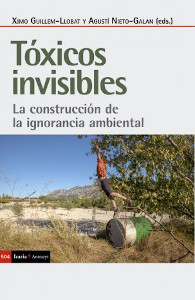
Toxicos Invisibles presents little-known stories of environmental pollution throughout the 20th century. It transports us to certain places, industries, regions, where the connivance of experts with public administrations and private companies has silenced and made the main victims of toxicity invisible: workers, activists, citizens in general. Through a set of rigorous historical research, the book shows how sophisticated mechanisms for the construction of ignorance are activated in these environmental conflicts that make it difficult to properly regulate products and recover diseased spaces, degraded in an almost irreversible way.
Invisible toxics denounces our deregulated industrial societies, complacent with the risks of thousands of synthetic products that invade our lives, and at the same time an appeal to the responsibility of all to improve our living conditions.
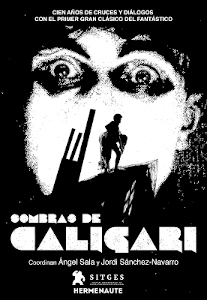
Coordinated by Ángel Sala and Jordi Sánchez-Navarro, the publication has a contribution from Carlos Tabernero, member of the CEHIC and UAB professor.
The book is being published to commemorate the centennial of The Cabinet of Doctor Caligari, the first major classic fantastical and horror film, and it explores its vast cinematographic and cultural legacy. The reader will find different perspectives on the enormous influence of the plot, the staging and the narrative resources of the film in subsequent cinema and television, without ignoring the genesis of Caligari, the sociopolitical framework and the debates sparked by its interpretation throughout history.
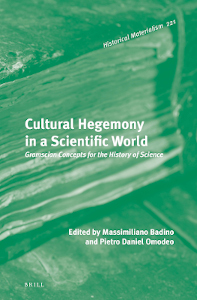
Massimiliano Badino and Pietro Daniel Omodeo (eds.), Cultural Hegemony in a Scientific World. Gramscian Concepts for the History of Science. Historical Materialism Book Series, Volume: 221, Brill, 2020.
This volume in political epistemology offers a comprehensive discussion of the multiple applicability of Gramscian concepts and categories to the historical, sociological, and cultural analysis of science. The authors argue that the perspective of hegemony and subalternity allows us critically to assess the political directedness of scientific practices as well as to reflect on the ideological status of disciplines that deal with science at a meta-level – historical, socio-historical, and epistemological.
The IHC's Contributors include:
Chapter 1 Past and Present: Revisiting ‘Gramscianism’
Author: Agustí Nieto-Galan [pages 19–38]
Chapter 8 Using Gramsci’s Dialogical Approach: The Struggle for Meaning in Q&A Sections of the Spanish Press in the First Third of the Twentieth Century
Authors: Isabel Jiménez-Lucena, Jorge Molero-Mesa, and Carlos Tabernero-Holgado [pages 203–242]
Chapter 12 Philanthropy, Mass Media, and Cultural Hegemony: The Rockefeller Foundation and the Politics of Science Popularisation in the 1930s
Author: Jaume Sastre-Juan [pages 297–318]
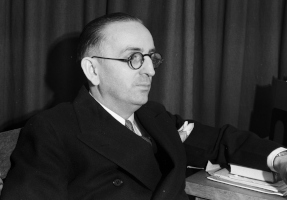
“Philanthropy, Mass Media and Cultural Hegemony: the Rockefeller Foundation and the Politics of Science Popularization in the 1930s”, in Badino, Massimiliano; Omodeo, Pietro Daniel (eds.), Cultural Hegemony in a Scientific World: Gramscian Concepts for the History of Science, Leiden, Brill, 297-318.
In 1938 and 1939, the Rockefeller Foundation organised two confidential conferences ‘On the Interpretation of Science for a General Public’, commissioned an exhaustive survey of contemporary science popularisation in the United States and actively participated in international efforts in this field under the auspices of the Paris-based International Institute for Intellectual Cooperation of the League of Nations. The chapter places the interest of the Rockefeller Foundation in science popularisation at the intersection of two of its main concerns in the late 1930s, which were at the same time two key elements in the struggle for cultural hegemony in the United States: science and mass communications. It argues that a Gramscian approach, which understands science popularisation as a tool in the struggle for cultural hegemony, allows us to make sense of the Rockefeller Foundation’s interest in science popularisation in the late 1930s.
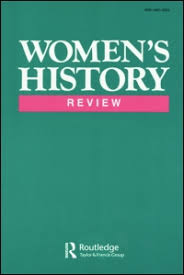
"The historical understanding of female premodern possessions. Problematizing some gender assumptions in the historiography on Teresa de Ávila and Jeanne des Anges", Women's History Review, 29:1, 2020, 125-141.
This paper discusses how to approach the history of female possessions today. By analyzing some recent contributions applied to two well-known historical figures: Teresa de Ávila (1515–1582) and Jeanne des Anges (1602–1665), I will problematize some of the ongoing history of female possessions. I intend a reflection on two of the current conceptual frameworks that feature the way history explains the subjective experience of these premodern possessed individuals. I focus on two kinds of interpretation: one I call the ‘neurotic’ interpretation, and the other the ‘subversive’ interpretation. Both constructions underpin explanations of women’s divine and demonic possessions, involving historiographical gender prejudices and ahistorical assumptions.
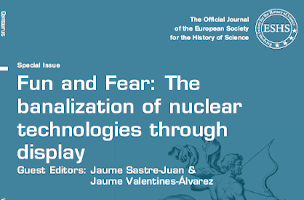
How do nuclear technologies become commonplace? How have the borders between the exceptional and the banal been drawn and redrawn over the last 70 years in order to make nuclear energy part of everyday life?
These are some of the questions addressed in ‘Fun and Fear: The Banalization of Nuclear Technologies through Display’, a recently published special issue of the journal Centaurus co-edited by the member of the CEHIC Jaume Sastre-Juan.
The translation of Freud's Complete Works by Luis López Ballesteros in 1922 placed Freudian ideas in the focus of Spanish specialists. There are numerous studies on the resistance and rejection with which these works were received. The Psicoanálisis y defensa social en España, 1923-1959 shows the other side: through the different dimensions of the life of the individual and the society to which psychoanalysis was applied, he realizes the success of its expansion, the reinterpretations and reappriations that took place between the twenties of the last century and in the Franco dictatorship. Silvia Lévy Lazcano presents in this work a rigorous discourse that accompanies initiates and newcomers in the knowledge of authors and their approach, through psychoanalysis, mental illness, psyche, human behavior and relationships, sexuality, gender identities and, in general, the gears of modern subjectivity.

Agustí Nieto-Galan argues that chemistry in the twentieth century was deeply and profoundly political. Far from existing in a distinct public sphere, chemical knowledge was applied in ways that created strong links with industrial and military projects, and national rivalries and international endeavours, that materially shaped the living conditions of millions of citizens. It is within this framework that Nieto-Galan analyses how Spanish chemists became powerful ideological agents in different political contexts, from liberal to dictatorial regimes, throughout the century. He unveils chemists' position of power in Spain, their place in international scientific networks, and their engagement in fierce ideological battles in an age of extremes. Shared discourses between chemistry and liberalism, war, totalitarianism, religion, and diplomacy, he argues, led to advancements in both fields.
The Dark Side of Molecules: Politics and Chemistry in the 20th century
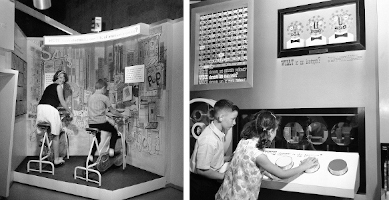
“‘If You Tilt This Game, Will It Explode?’: The Politics of Nuclear Display at the New York Hall of Science, 1966-1973’”, Centaurus, 61(1), 2019, 33-50.
This article analyzes the politics of nuclear display at the New York Hall of Science in the late 1960s and early 1970s. The Hall of Science, which had its origins in the 1964-65 New York World’s Fair, featured hands-on atomic exhibits for children and projected a monumental Nuclear Science Center with the full support of the Atomic Energy Commission. The Nuclear Science Center, which would have been the biggest permanent display on nuclear science and technology in the United States, would have included the Atomarium as its most spectacular exhibit. At the Atomarium, visitors would have been able to watch a working nuclear reactor go critical from a spiral-shaped theater-in-the-round, while a demonstrator standing on a transparent plexiglass window located right above the core lectured on the peaceful uses of atomic energy. This article analyzes the Hall of Science as a space in which the tensions between nuclear exceptionalism and nuclear banalization were played out. In particular, the article explores how playful and immersive regimes of display were intended to play a political role in modulating nuclear fear at a period in which the promotion of a private nuclear energy industry by the Atomic Energy Commission encountered growing resistances to nuclear power plants.
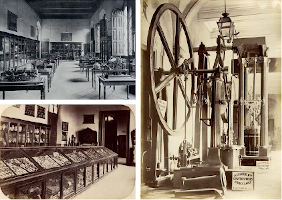
“The Failed Technology Museum of Catalonia: Engineers and the Politics of the Musealization of Technology in Barcelona (1929-1939)”, Nuncius, 34(1),2019, 128-154.
In March 1937, the Technology Museum of Catalonia was created by a governmental order, but it never materialized. How come was a national museum of technology perceived as an urgent need in the midst of the Spanish Civil War? This article explores how this failed attempt was rooted in the long-standing political interest of the engineering community in the musealization of technology in Barcelona. On the one hand, it analyses the tradition of technological display aimed at increasing industrial productivity and improving technical education. On the other hand, it studies the techno-nationalist efforts by engineers to construct a respectable technological past for the nation through display. Finally, it explores how these two approaches would have been articulated in the Technology Museum of Catalonia in the context of the key role played by engineering professionals during the Spanish Civil War
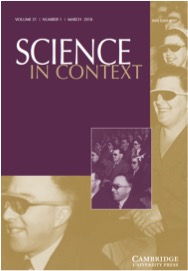
"The changing nature of modernization discourses in documentary films". Science in Context, 2018, 31(1): 61-83.
Franco’s fascist regime in Spain (1939-1975) offers the possibility of exploring the complex relationship between media communication practices and the processes of production, circulation, and management of knowledge. The regime persistently used film, and later on television, as indoctrination and disciplining devices. These media thus served to shape the regime’s representation,which largely relied on the generation of positive attitudes of adherence to the rulers through people’s submission and obedience to experts. This article examines the changing nature of modernization discourses and practices, as a fundamental element of the regime’s propaganda strategies, and as portrayed in documentaries produced under its rule. The rhetoric of modernization involved an explicit deficit model of knowledge management, which aimed at legitimating the regime’s deeds and policies in its first decades, as we shall see regarding colonial-medical documentaries produced for the official newsreel in the 1940s. However, the focus of such rhetoric, despite its enduring political aims, had to somehow open up as the relationship between experts and non-experts changed, both in epistemological and practical terms, such as in wildlife documentary films produced for television in the 1970s, the regime’s last decade.

